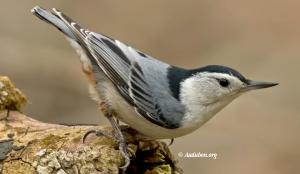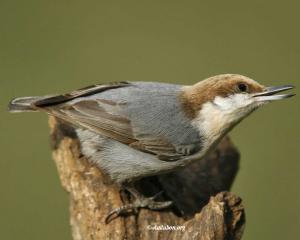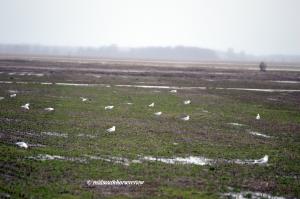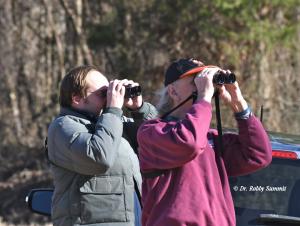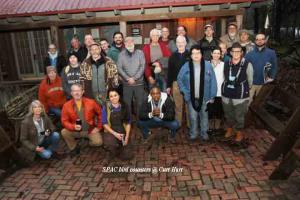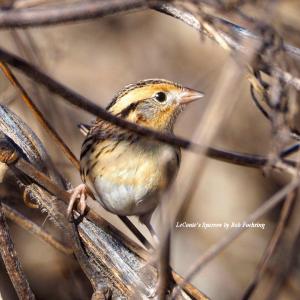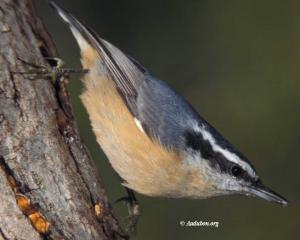By Nancy Brannon, with information from Mitch Robinson
[Download Winter Wildlife Habitat]
Strawberry Plains Audubon Center (SPAC), Holly Springs, Mississippi, began the New Year with their first Christmas Bird Count on Saturday January 5, 2019. This SPAC bird count is part of the national Audubon Society Christmas Bird Count (CBC), which is the nation’s longest running community science bird project. Occurring annually in over 2,500 locations across the Western Hemisphere, this winter marked the 119th CBC, and 37 people came to SPAC for their first ever Christmas Bird Count. Hosted by the staff and friends of SPAC, this all-day count was held in lieu of their annual Winter Bird Count, and expanded the range beyond SPAC’s sanctuary boundary to a 15-mile diameter circle centered about 5 miles southeast of SPAC. The count’s location was chosen to provide opportunities to find birds among Marshall County’s varied habitats (e.g., Hudsonville grasslands, Chewalla Lake Recreation Area, Duck Pond, Holly Springs National Forest, as well as SPAC). The CBC also provides a great opportunity to engage and educate participants on winter bird species, while highlighting the importance of community science projects for measuring long-term trends in species’ abundance.
Mitch Robinson, Conservation Education Manager at SPAC said that the bird count was by far the largest Christmas Bird Count at SPAC, viewing 86 species of birds, with 5,176 individual birds counted. “Some unique bird species of note included the blue-headed vireo, all three nuthatches (white-breasted, red-breasted, brown-headed), LeConte’s sparrow, and the American woodcock.”
Why is counting birds in the winter important?
Mitch Robinson says, “A new study shows that there is a large discrepancy between the number of birds migrating in the fall and spring, meaning winter habitats are possibly declining across the Americas, or development in Latin America is rapidly depleting former over-wintering habitat.
Audubon just published an article on this: https://www.audubon.org/magazine/winter-2018/how-many-birds-disappear-between-migration.”
In addition to the Christmas Bird Count, there is also the Great Backyard Bird Count, which is February 15-18. This backyard bird count is important because, Robinson explains: “No single scientist or team of scientists could hope to capture information about birds across the United States and Canada in four days. The CBC is only possible thanks to the help of tens of thousands of people counting birds in more than 15 countries during the same period every year. The more people who participate, the better record we will have of this year’s birds. Scientists can use the information to track the ups and downs of bird populations and to learn more about their migratory movements. Scientists can use the information to track year-to-year changes in the abundance and distribution of birds. They learn about the complex patterns of winter bird movements. And they can look for trends that indicate how well birds are faring through environmental changes such as urbanization, global climate change, and disease.”
Why do birds matter?
If you read the article “Why Birds Matter,” by Jonathan Franzen with stunning photographs by Joel Sartore, the featured article in the January 2018 edition of National Geographic, you learn that birds benefit all of us. Franzen concludes: “Beyond the sheer joy they provide, birds play a vital role in the environment, pollinating plants, dispersing seeds, controlling insects, and removing rotting flesh. ‘The future of birds, and us, are intertwined more than we know,’ writes photographer Joel Sartore in Birds of the Photo Ark. ‘We soar, or plummet, together.’”
If you would like to attract birds to your back yard, what types bird feeders and what types of bird seed attract what types of birds”
Mitch Robinson advises: “There are literally thousands of different seed mixes you can buy. At SPAC, we keep it simple and cost effective by shopping at our local bi-county CoOp and buying 50 lbs. bags of Black Oil Sunflower Seed.
“Another great addition is Suet.
“Place the feeders in places you want to watch birds. It’s as simple as that! For example, place a feeder outside a window, but be sure to keep it a minimum of five or so feet from the window, or you might get window strikes from birds.
“The suet can be put directly onto the sides of trees or anything in your yard, as the peanut butter makes it adhesive.
“The seed will attract several sparrow species, nuthatches, goldfinch, chickadees, titmice. The suet attracts all sorts of birds year round, but in the winter usually nuthatches, brown creepers, Woodpeckers (red-bellied, downy, hairy, Yellow-bellied Sapsucker, Northern Flicker) and anything else looking for some good carbs and protein. “
Owls
Northern Saw-whet Owls have arrived at SPAC. This tiny owl, weighing roughly the same as an American Robin, breeds in the boreal forests of the northern United States and Canada. They are a highly migratory species in the spring and fall, but there is limited information about their movements this far south, with less than two confirmed records in the state of Mississippi, both dating back to the mid-1970s. After research and consultation with successful banding operations in neighboring states, SPAC staff and researchers set out to capture this species on SPAC property, and succeeded. Through use of an audio lure and mist nets, they were able to attract and band a few of these birds last fall, making these the first Northern Saw-whet Owls banded in Mississippi! This included a recaptured female that was initially banded in southwestern Missouri in 2016. It’s been exciting and significant research for Audubon and Mississippi. It’s a hoot!
Delta Wind Birds
Winter birding in the northern Mississippi Delta can be very exciting, with huge flocks of wintering geese (Snow, Ross’s, Greater White-fronted) and other waterfowl and good chances for local specialties such as Sandhill Crane, LeConte’s Sparrow, Brewer’s Blackbird, and beautiful color morphs of Red-tailed Hawk. On Sunday, January 13Delta Wind Birdshosted a winter birding outing in Batesville, Mississippi and the nearby agricultural lands of Panola County. Sandhill Cranes typically spend each winter there; rare Red-tailed Hawk color morphs (such as Krider’s and Harlan’s) are often reported in the area; and there is a reliable spot to see the beautiful and elusive Le Conte’s Sparrow. Along the way, folks could enjoy large flocks of Snow and Ross’s Geese and other waterfowl, keep an eye out for Rusty and Brewer’s Blackbirds, and possibly have views of Bald Eagles. In addition, Sardis Dam is a good place to see waterfowl and gulls, including Lester the Lesser Black-backed Gull who has resided there for many winters. The trip included a lot of roadside birding, with some optional short walks. Registration was required, but all net proceeds went to support Delta Wind Birds’ efforts to foster habitat for migratory shorebirds in the Mississippi Delta.
More Bird Events
SPAC hosts a Grassland Birding & Sparrow ID workshop on February 23rd.
The annual Woodcocks, Wine, & Art fundraising event will be held at the Treehouse Gallery at 328 County Road 418 in Oxford, Mississippi on March 2nd.
Creating Shore Bird Habitat
In 2018, Delta Wind Birds tried a new approach to creating shorebird habitat, implementing a progran that had been in the works for a couple of years. Groundwater is precious and levels are declining in Mississippi, especially in the Delta. So, Delta Wind Birds had been searching for ways to create shorebird habitat that minimizes or eliminates the need to pump groundwater. The organization began searching for farmers with surface water retention systems, which allow them to capture runoff from their fields, store it in a reservoir, and re-use it later for irrigation. It turns out that these farmers sometimes have significant amounts of surface water left in their reservoirs after their crops are harvested. Delta Wind Birds’ idea was to find farmers willing to pump some of this water onto their fields after crop harvest, to create habitat for shorebirds during fall migration.
Fall flooding of crop fields has been shown to create decent shorebird habitat, but previously was done with precious groundwater, which also has the disadvantage of being cold and relatively devoid of organisms. As such, groundwater, now on the surface, usually takes weeks to be colonized by sufficient invertebrate animals to provide high-quality food for migratory shorebirds. Delta Wind Birds hoped that re-using surface water would not only save groundwater, but also would provide high-quality habitat more quickly, since the water is warmer and is pre-inoculated with populations of invertebrate animals.
Their experiment seems to have worked. Delta Wind Birds partnered with Mr. James Failing, a crop farmer near Indianola, Mississippi, and tried this strategy on some of his fields last fall, from late September through October, 2018. Mr. Failing put the first water onto his fields on September 20th. When Delta Wind Birds staff first checked for birds on September 30th, the site was already attracting hundreds of shorebirds, and they estimate that the site provided habitat for upwards of 2000 shorebirds, at least 13 species, through the month of October. Delta Wind Birds is grateful to Andy Bell and Jeff Harris for conducting regular monitoring of the site, and to Mr. Failing for being willing to work with Delta Wind Birds. The organization hopes to expand this conservation strategy in fall 2019, if they can raise sufficient funds.
Here is a link to one of Jeff Harris’s eBird checklists, including quite a few nice bird photos:
https://ebird.org/view/checklist/S49027466
[Download Winter Wildlife Habitat]
Strawberry Plains Audubon Center (SPAC), Holly Springs, Mississippi, began the New Year with their first Christmas Bird Count on Saturday January 5, 2019. This SPAC bird count is part of the national Audubon Society Christmas Bird Count (CBC), which is the nation’s longest running community science bird project. Occurring annually in over 2,500 locations across the Western Hemisphere, this winter marked the 119th CBC, and 37 people came to SPAC for their first ever Christmas Bird Count. Hosted by the staff and friends of SPAC, this all-day count was held in lieu of their annual Winter Bird Count, and expanded the range beyond SPAC’s sanctuary boundary to a 15-mile diameter circle centered about 5 miles southeast of SPAC. The count’s location was chosen to provide opportunities to find birds among Marshall County’s varied habitats (e.g., Hudsonville grasslands, Chewalla Lake Recreation Area, Duck Pond, Holly Springs National Forest, as well as SPAC). The CBC also provides a great opportunity to engage and educate participants on winter bird species, while highlighting the importance of community science projects for measuring long-term trends in species’ abundance.
Mitch Robinson, Conservation Education Manager at SPAC said that the bird count was by far the largest Christmas Bird Count at SPAC, viewing 86 species of birds, with 5,176 individual birds counted. “Some unique bird species of note included the blue-headed vireo, all three nuthatches (white-breasted, red-breasted, brown-headed), LeConte’s sparrow, and the American woodcock.”
Why is counting birds in the winter important?
Mitch Robinson says, “A new study shows that there is a large discrepancy between the number of birds migrating in the fall and spring, meaning winter habitats are possibly declining across the Americas, or development in Latin America is rapidly depleting former over-wintering habitat.
Audubon just published an article on this: https://www.audubon.org/magazine/winter-2018/how-many-birds-disappear-between-migration.”
In addition to the Christmas Bird Count, there is also the Great Backyard Bird Count, which is February 15-18. This backyard bird count is important because, Robinson explains: “No single scientist or team of scientists could hope to capture information about birds across the United States and Canada in four days. The CBC is only possible thanks to the help of tens of thousands of people counting birds in more than 15 countries during the same period every year. The more people who participate, the better record we will have of this year’s birds. Scientists can use the information to track the ups and downs of bird populations and to learn more about their migratory movements. Scientists can use the information to track year-to-year changes in the abundance and distribution of birds. They learn about the complex patterns of winter bird movements. And they can look for trends that indicate how well birds are faring through environmental changes such as urbanization, global climate change, and disease.”
Why do birds matter?
If you read the article “Why Birds Matter,” by Jonathan Franzen with stunning photographs by Joel Sartore, the featured article in the January 2018 edition of National Geographic, you learn that birds benefit all of us. Franzen concludes: “Beyond the sheer joy they provide, birds play a vital role in the environment, pollinating plants, dispersing seeds, controlling insects, and removing rotting flesh. ‘The future of birds, and us, are intertwined more than we know,’ writes photographer Joel Sartore in Birds of the Photo Ark. ‘We soar, or plummet, together.’”
If you would like to attract birds to your back yard, what types bird feeders and what types of bird seed attract what types of birds”
Mitch Robinson advises: “There are literally thousands of different seed mixes you can buy. At SPAC, we keep it simple and cost effective by shopping at our local bi-county CoOp and buying 50 lbs. bags of Black Oil Sunflower Seed.
“Another great addition is Suet.
“Place the feeders in places you want to watch birds. It’s as simple as that! For example, place a feeder outside a window, but be sure to keep it a minimum of five or so feet from the window, or you might get window strikes from birds.
“The suet can be put directly onto the sides of trees or anything in your yard, as the peanut butter makes it adhesive.
“The seed will attract several sparrow species, nuthatches, goldfinch, chickadees, titmice. The suet attracts all sorts of birds year round, but in the winter usually nuthatches, brown creepers, Woodpeckers (red-bellied, downy, hairy, Yellow-bellied Sapsucker, Northern Flicker) and anything else looking for some good carbs and protein. “
Owls
Northern Saw-whet Owls have arrived at SPAC. This tiny owl, weighing roughly the same as an American Robin, breeds in the boreal forests of the northern United States and Canada. They are a highly migratory species in the spring and fall, but there is limited information about their movements this far south, with less than two confirmed records in the state of Mississippi, both dating back to the mid-1970s. After research and consultation with successful banding operations in neighboring states, SPAC staff and researchers set out to capture this species on SPAC property, and succeeded. Through use of an audio lure and mist nets, they were able to attract and band a few of these birds last fall, making these the first Northern Saw-whet Owls banded in Mississippi! This included a recaptured female that was initially banded in southwestern Missouri in 2016. It’s been exciting and significant research for Audubon and Mississippi. It’s a hoot!
Delta Wind Birds
Winter birding in the northern Mississippi Delta can be very exciting, with huge flocks of wintering geese (Snow, Ross’s, Greater White-fronted) and other waterfowl and good chances for local specialties such as Sandhill Crane, LeConte’s Sparrow, Brewer’s Blackbird, and beautiful color morphs of Red-tailed Hawk. On Sunday, January 13Delta Wind Birdshosted a winter birding outing in Batesville, Mississippi and the nearby agricultural lands of Panola County. Sandhill Cranes typically spend each winter there; rare Red-tailed Hawk color morphs (such as Krider’s and Harlan’s) are often reported in the area; and there is a reliable spot to see the beautiful and elusive Le Conte’s Sparrow. Along the way, folks could enjoy large flocks of Snow and Ross’s Geese and other waterfowl, keep an eye out for Rusty and Brewer’s Blackbirds, and possibly have views of Bald Eagles. In addition, Sardis Dam is a good place to see waterfowl and gulls, including Lester the Lesser Black-backed Gull who has resided there for many winters. The trip included a lot of roadside birding, with some optional short walks. Registration was required, but all net proceeds went to support Delta Wind Birds’ efforts to foster habitat for migratory shorebirds in the Mississippi Delta.
More Bird Events
SPAC hosts a Grassland Birding & Sparrow ID workshop on February 23rd.
The annual Woodcocks, Wine, & Art fundraising event will be held at the Treehouse Gallery at 328 County Road 418 in Oxford, Mississippi on March 2nd.
Creating Shore Bird Habitat
In 2018, Delta Wind Birds tried a new approach to creating shorebird habitat, implementing a progran that had been in the works for a couple of years. Groundwater is precious and levels are declining in Mississippi, especially in the Delta. So, Delta Wind Birds had been searching for ways to create shorebird habitat that minimizes or eliminates the need to pump groundwater. The organization began searching for farmers with surface water retention systems, which allow them to capture runoff from their fields, store it in a reservoir, and re-use it later for irrigation. It turns out that these farmers sometimes have significant amounts of surface water left in their reservoirs after their crops are harvested. Delta Wind Birds’ idea was to find farmers willing to pump some of this water onto their fields after crop harvest, to create habitat for shorebirds during fall migration.
Fall flooding of crop fields has been shown to create decent shorebird habitat, but previously was done with precious groundwater, which also has the disadvantage of being cold and relatively devoid of organisms. As such, groundwater, now on the surface, usually takes weeks to be colonized by sufficient invertebrate animals to provide high-quality food for migratory shorebirds. Delta Wind Birds hoped that re-using surface water would not only save groundwater, but also would provide high-quality habitat more quickly, since the water is warmer and is pre-inoculated with populations of invertebrate animals.
Their experiment seems to have worked. Delta Wind Birds partnered with Mr. James Failing, a crop farmer near Indianola, Mississippi, and tried this strategy on some of his fields last fall, from late September through October, 2018. Mr. Failing put the first water onto his fields on September 20th. When Delta Wind Birds staff first checked for birds on September 30th, the site was already attracting hundreds of shorebirds, and they estimate that the site provided habitat for upwards of 2000 shorebirds, at least 13 species, through the month of October. Delta Wind Birds is grateful to Andy Bell and Jeff Harris for conducting regular monitoring of the site, and to Mr. Failing for being willing to work with Delta Wind Birds. The organization hopes to expand this conservation strategy in fall 2019, if they can raise sufficient funds.
Here is a link to one of Jeff Harris’s eBird checklists, including quite a few nice bird photos:
https://ebird.org/view/checklist/S49027466
